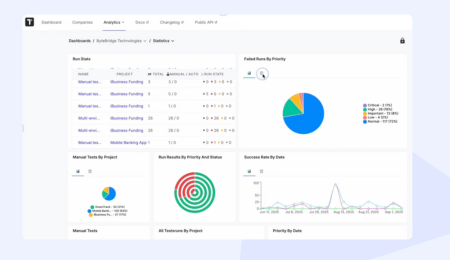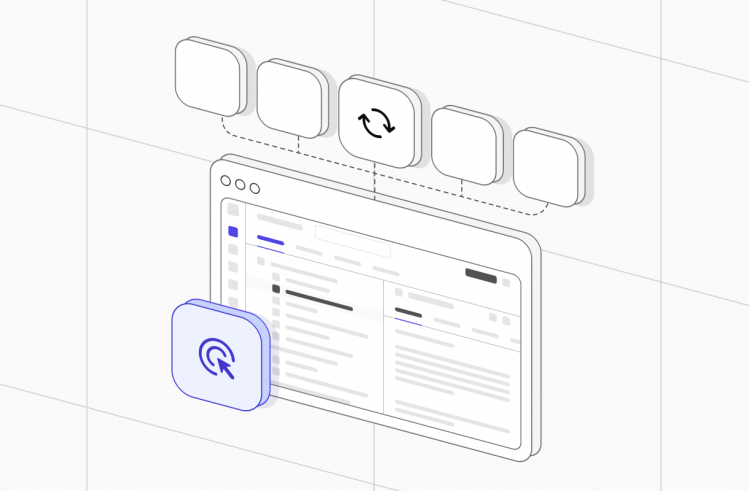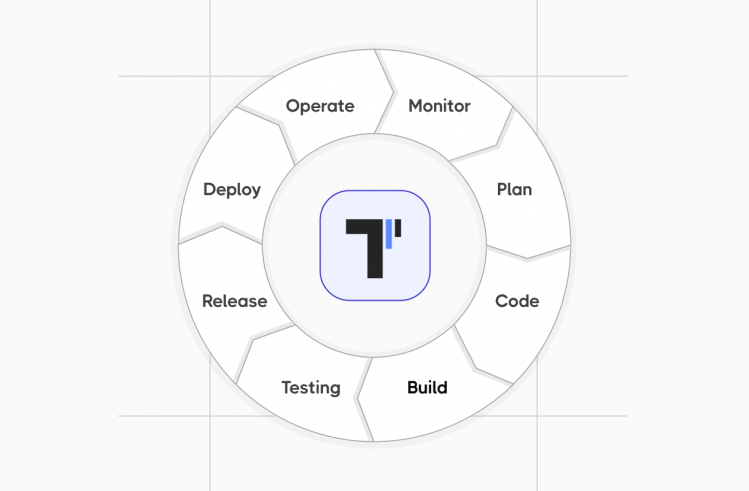In every project, teams make many decisions — from fixing software bugs to assuring business goals align across departments. Within defect management, QA, development, and testing teams work closely to identify, prioritize, and resolve issues with ease. This process not only involves fixing bugs but also documenting and sharing decisions across the entire software development cycle. By establishing a well-organized and proactive defect management process, teams can bring clarity to the software defect process and reduce risks in the long run.
Let’s discover more details about defect management best practices and tips in the article below ⬇️
Defects in Software Testing
In software testing, a defect is any error or failure occurred in the software applications as a result of code errors, incorrect logic, inadequate implementation, or unexpected issues between various software components. These errors lower the practical value of software which leads to unpredictable results as well as poor and slow performance. You can also learn the key difference between defects and bugs here.
Let’s imagine the following scenario of testing E-shop:
- Internet user wants to make a purchase
- User adds items to the shopping cart
- User presses a button to Buy
- Fill in his payment data and follow the instruction
🛒 While testing the shopping cart, the team discovers a bug:
- User enters payment information
- The payment becomes unsuccessful, he can see a message a server errors
🔴 It has happened due to issues related to the gateway connection.
Finding true defects is always challenging. It is vital to dig deeper during the defect management process. This avoids misinterpretations and assures that the software meets users’ needs.
Mykhailo Poliarush, CEO, Testomat.io
Common types of defects
Categorizing these defects helps testers and developers address them effectively. Look into distingushing the different types of issues that may be encountered during the software testing process:
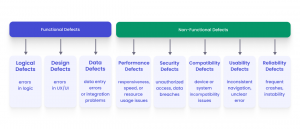
- Functional defects. These defects are issues in the software. They block the program features from working as expected and meeting its specs. Depending on the defect’s source, they can be logical, interface, or data errors.
- Non-functional defects. These defects are issues in the software. They hurt performance, security, usability, stability, and compatibility. Non-functional defects are categorized into performance, security, reliability, usability, and compatibility issues.
- Logical defects. These defects are errors in the software’s logic. They arise from flawed algorithms, incorrect assumptions, or poor design decisions. They lead to incorrect results or unexpected behavior. Common types of logical issues are calculation, data processing, and algorithm errors.
- Design defects (UX/UI). These defects are flaws in a UI or UX design. They hurt the user experience and reduce interaction efficiency.
- Data defects. These defects are known as problems with data. They reduce its quality and reliability. They come from various sources, like data entry errors and system failures. Also, there are faulty integrations.
Defect management in software testing
In testing, defect management is the systematic process that helps teams detect and eliminate software issues to deliver software products of high quality. By identifying, documenting, prioritizing, tracking, and resolving software issues, teams can guarantee that the final product meets project requirements and user needs.
While the goals of implemented defect management process can vary from one QA team or project to the next, the approach must be the same for every team. Every team should answer where to report, who to involve, how to fix and track, etc.
👉 With well-organized issue management, development teams can maintain the software’s quality and reduce costs.
Why Defect Management Matters
We all know that high-quality software and happy users are a requirement for all kinds of businesses. And every business is trying to achieve this goal. Most companies end up with defect management practices. Here is why the management of issues is crucial for your business:
- It enables teams to quickly identify and address issues as well as enhance the speed and effectiveness of defect resolution.
- It encourages cross-team collaboration by helping QA, development, and testing teams work together smoothly to resolve issues.
- With a focus on prioritizing and fixing issues quickly, it allows teams to deliver high-quality software faster.
- It supports a structured, systematic approach and contributes to more reliable and stable software.
- Analyzing and understanding the root causes of defects helps teams proactively prevent similar issues in the future and reduce the risks upfront.
- With issue management in place, companies can adopt a culture of quality by prioritizing defect management and focusing on quality as a consistent priority across the project.
Best Practices and Tips for Effective Defect Management

Implementing defect management best practices allows organizations to significantly improve software quality. End up if they adhere to these guidelines, development teams can streamline their defect management processes, reduce development costs, and meet user needs in the final software product.
Software issues don’t come cheap. We know that someone pays for them. When adopting defect management best practices, we can prevent or minimize these costs.
Here’s a breakdown of the key stages of the process and defect management best practices for optimizing the process and achieving success:
#1: Identification
At this step, teams have a main focus on identifying as many errors as possible early in the software development process. They perform various types of testing – unit testing, integration testing, and acceptance testing. They also attempt to fix the bugs quickly and minimize potential future expenses related to the resolution process. What helps teams detect and identify issues more effectively is:
- Applying a comprehensive testing approach. When combining various testing types, teams can test as the whole App as well its individual components, check how components work together, and validate the entire system to find mistakes early at different stages of the development lifecycle.
- Opting for automated testing tools. With automation in place, teams can speed up testing and increase test coverage. They can also integrate automation tools into the CI\CD pipeline in order to perform frequent testing and detect issues early.
- Using test case management systems. Teams can use test case management systems like testomat.io. These tools can integrate with issue tracking systems and enable teams to easily link tests and test suites to specific tickets. They can also create defects directly from failed test results – whether from automated runs or manual testing. Test management system testomat.io seamlessly integrates with Jira, Linear, AzureDevOps, GitHub issue systems.
- Incorporating a quality-first culture. You should provide a culture where team members can train and educate on different QA principles and testing techniques. Also, you can encourage regular code review processes and tracking key performance indicators. If combined, this will foster early issue identification, efficient resolution, and the delivery of high-quality software.
#2: Logging
At this step, QA testing teams aim to document and record issues identified during the development process. They will use this defect information to prioritize and assign errors for further fixing. With detailed information, they can make sure that anyone in the team can recreate the issue. That’s why it is important not only to describe the expected outcome and the actual behavior but also to attach visual evidence – screenshots or log files for better understanding. It needs to specify the operating system, browser, and other relevant system details as well. Here is a simple example of a standardized issue reporting template, you can do it with an xls table in a Google spreadsheet:

#3: Triage
In this stage, the teams and all stakeholders involved aim to evaluate and prioritize issues. They classify issues based on severity (critical, major, minor, trivial) and priority (low, medium, high or urgent). This helps them make sure that human resources are focused on resolving the most critical issues first. For a more efficient and hassle-free triage process, the following defect management best practices and tips may help you:
- Scheduling regular meetings with representatives from development, testing, and product management to review and prioritize errors is important.
- Everybody in the team should use a standardized form to document issue details, severity, priority, and assignment.
- Utilizing issue tracking tools like Jira, Bugzilla, or Azure DevOps will help you better track and manage errors.
💡 Test management system testomat.io supports the Advanced Defect Management analytics widget and issue defect linking options.
#4: Assignment
At this step, each logged issue is assigned to a specific developer or team. Assigned teams or team members will be responsible for fixing them. To resolve defects more efficiently, you need to do the following:
- Considering expertise, workload, and severity of issues. You need to consider factors such as developer expertise, workload, and severity of issues before assigning. It is essential to remember that experienced developers should fix critical bugs to guarantee a timely and effective defect resolution process.
- Balancing workloads. You need to regularly review the developer’s workload and assign issues accordingly to prevent burnout and maintain productivity.
- Automating notifications and reminders. You need to implement automated notifications and reminders to ensure the timely resolution of assigned issues among teams.
#5: Resolution
At this step, the development team prioritizes defect resolution based on severity and starts fixing them, marking it a critical phase in the defect management process. By using automated testing tools and frameworks, they resolve bugs more quickly and efficiently. They also utilize collaborative tools for more seamless communication between developers and testers. To improve the effectiveness of defect resolution, consider the following defect management best practices for this stage:
- Prioritizing based on severity and impact. You know that high-severity issues should be resolved first in order to maintain system stability. Only by prioritizing critical issues can you support software quality and reduce potential risks.
- Employing collaborative tools. With these tools in hand, you provide real-time communication between teams. This helps streamline defect verification and leads to efficient and effective defect resolution.
- Documenting fixes and updating statuses. You need to document each bug fix and update its status in the tracking system. This keeps all team members informed and allows testers to validate the fix as soon as possible.
#6: Verification
At this step, testing teams verify that the resolved defects have been fixed correctly and without introducing new issues. To make this process more effective, you should focus on the following defect management best practices:
- Thorough retesting. Once the defects have been fixed, you need to perform comprehensive retesting of the fixed to make sure they are resolved correctly and function as expected.
- Regression testing. To maintain overall system stability, you need to detect any unintended side effects of the fix on other parts of the system with regression testing.
- Test case design. To cover all relevant scenarios, you need to create appropriate test cases to confirm that the issue has been fully resolved under various conditions.
- Issue status and documenting results. You need to remember to update the issue’s status in the tracking system and document the results of the verification process.
#7: Closure
At this step, verified issues are formally closed. The team confirms that all necessary checks have been completed and the issue is fully resolved. To close defects effectively, you need to consider the following defect management best practices for this stage:
- Gathering final approvals. It is essential to get confirmation from all relevant stakeholders, – testers and quality assurance leads to verify that the issue has passed all necessary retesting and regression testing and meets closure criteria.
- Updating documentation and issue status. Do not forget to update the issue status in the tracking system and related documents.
- Reviewing the issue. After an issue is fixed, you need to take a quick look to see if it reveals anything that could help in future process improvement.
#8: Reporting
At this stage, you can get valuable insights into the overall software quality and reveal areas for improvement within the development and testing processes. With a well-structured defect report, you can identify trends and root causes as well as discover areas for process optimization.
Here is a breakdown of how issue reporting in the defect management best practices contributes to continuous improvement:
- Identifying quality trends. When it comes to categorizing defects based on their frequency and severity, you can reveal patterns in recurring issues by analyzing where these defects occur. Whether it is in the UI, database, APIs, or specific features, this analysis helps teams identify potentially vulnerable areas and focus future testing on high-risk zones.
- Performing root cause analysis. When conducting a root cause analysis, teams can uncover reasons for design flaws, coding errors, or insufficient test coverage. With shared regular feedback, development, and testing teams can better identify and address recurring issues to reduce the likelihood of similar defects in future releases.
- Evaluating testing strategy. If many bugs are identified during later phases of testing (e.g., integration or user acceptance testing), it may indicate gaps in the earlier stages of testing. That’s why teams need to reassess the test strategy for better coverage and early issue detection in future cycles.
- Defect tracking. By tracking metrics such as defect density and leakage rates, teams can quantify software quality and identify areas for improvement. You can analyze defect resolution times to highlight bottlenecks (slow response times from the development team or inefficient workflows) in the defect management process and optimize it.
- Preparing for release. With defect reporting, teams can evaluate whether the software is ready for release by tracking the status of issues against the release criteria. If certain defects can not be fixed in time, teams must decide whether to release or delay.
If your issue management does not work properly, it can lead to inefficiencies, misunderstanding among teams, and even missed product releases. Not to mention all the extra time and dollars you will spend on fixing the bugs. That’s why you need to adopt defect management best practices to better track, assign, and resolve issues. The more efficient the process is, the faster you can deliver the final software products.
Defect Metrics to Monitor
Metrics are a valuable tool in defect management best practices that are worth investing time and effort. To answer day-to-day questions about the health of an issue process, you need to use appropriate metrics. Here we are going to overview the most popular metrics used during the defect management process:
Defect Density
This quality metric is used to measure the number of issues per unit of functionality. It helps assess code quality and pinpoint areas for improvement. You need to remember that lower defect density signifies higher quality.
Defect Detection Percentage (DDP)
This metric is used to calculate the percentage of issues found during testing vs. after release. By measuring the effectiveness of testing processes, a higher DDP signals earlier bug detection and reduced risk of production issues, contributing to overall software quality.
Escaped Defects
This quality metric is used to measure defects found after software release. It monitors the number of defects that were not identified during the testing phase.
Defect Leakage Rate
This metric is used to track the percentage of issues that escape into production. It measures the ability of the QA process to identify and prevent defects.

Defect Rejection Rate
This metric is used to evaluate the level of misclassification in defect reporting. It shows the efficiency of the issue reporting and triage process.
Mean Time to Detect (MTTD)
This metric is used to monitor the average time to identify a defect. It measures the time taken to identify and report defects.
Mean Time to Resolve (MTTR)
This metric is used to track the average time to fix a bug. It assesses the efficiency of the development team in resolving defects.
There’s a lot to consider when monitoring, so teams should use numerous metrics to gain a deep yet broad understanding of code quality, testing effectiveness, and issue resolution times, so to meet more metrics you can in the next pages of this testing blog:
Benefits of Defect Management
Here we are going to present the benefits you can realize with the defect management process:
- You can develop and launch software of high quality and catch issues before they escalate by finding and fixing issues early in the process.
- You can speed up defect resolution and accelerate software releases thanks to streamlined issue tracking and well-organized communication and collaboration across teams.
- With a well-polished process, you can minimize costly and late-stage bug fixes by optimizing resource use and lowering expenses on the project.
- Delivering reliable, high-quality software builds trust with users and increases customer satisfaction.
- You can learn from past issues and spot trends so that teams can refine their processes and prevent recurring errors.
Limitations of Defect Management
While defect management offers numerous advantages, it is not without its limitations. Let’s review them below:
- If you do not handle the defect management process correctly, the software development cost will rise.
- If you do not manage issues early, the defects can cause more damage.
- If the process is not done correctly, your company could lose revenue, customers, and brand reputation.
- If you overload your teams with a high volume of bugs, it can lead to decreased productivity and burnout.
- If bugs remain unresolved, you face performance issues, security vulnerabilities, and dissatisfied users.
- If you do not carefully fix bugs, there is a risk of introducing new issues and a more complex and time-consuming issue resolution process.
Bottom Line: Ready to use Defect Management Best Practices?
Only by properly managing this process, teams can keep projects on track. That’s why they should adopt defect management best practices and useful tips to enhance their workflow and improve the overall process. Following these defect management best practices not only boosts software quality but also helps reduce development costs and launch reliable and error-free software products. Enhancing your defect management process is possible with the powerful capabilities of our test management tool:
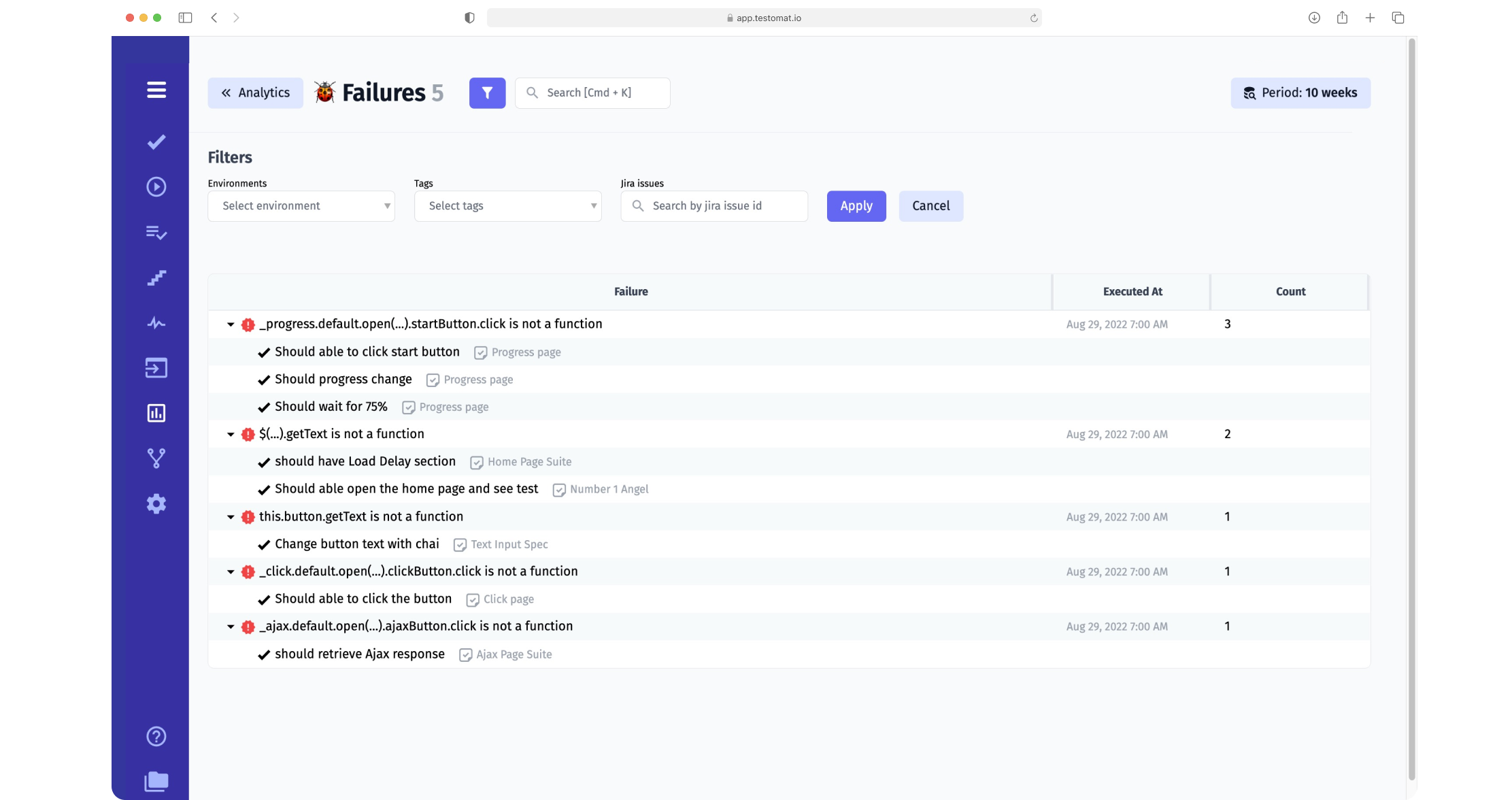
If you have any questions about implementing defect management best practices together us and our test management solution, drop us a line without hesitation.
